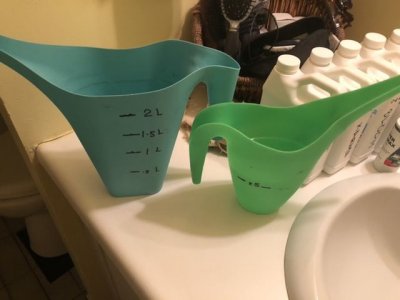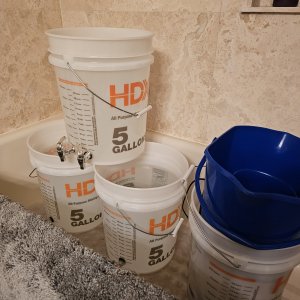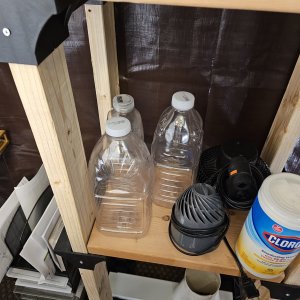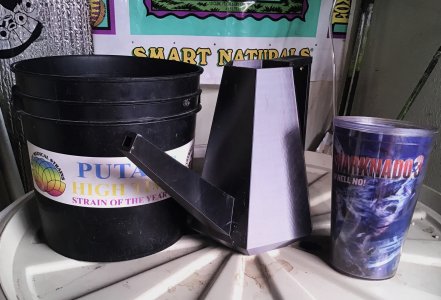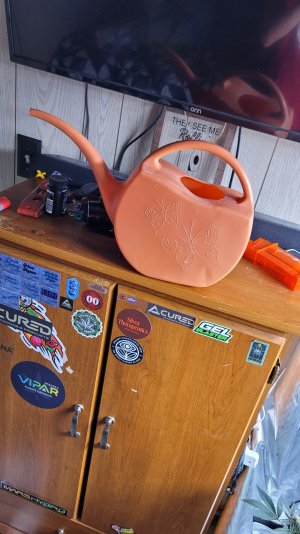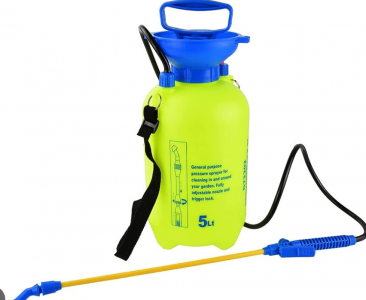- Joined
- May 11, 2023
- Messages
- 1,696
- Reaction score
- 7,748
This will be a long read based on my personal knowledge, opinions, research and others work to consolidate information for our members. I'm not presenting my opinions as facts so take from this what you like. I will be putting it in subsection format for easy reference.
First I want to make an important point to take into consideration before reading. The tap root will grow directly downwards to the bottom of the container before spreading out.
PERCHED WATER TABLE
What is it?
The perched water table is basically the height of the saturation zone where capillary action and gravity cancel eachother out. This area will be saturated with water and will be responsible most growers issues with watering practices especially in soil grows.
WHAT IS CAPILLARY ACTION
CAPILLARY action is is the combination of the cohesive and adhesive properties of water.
In short adhesion is water clinging to the media (think of it like wicking or soaking up)
Cohesion is where the water clings to itself.
So as the water is wicked up (adhesion) it pulls more water with it through Cohesion and at the point gravity and these properties cancel eachother out is the perched water table.
This perched water table will always remain the SAME HEIGHT and will always stay saturated unless taken up by the plants or evaporates when the pot dries out. No matter the container height, depth or volume of media. So if a tall skinny container had a perched water table of 1" then a short wide one of the same media will also have a perched water table of 1". Which means the ratio of water to air in a wide pot will be higher than a tall skinny pot which will have a higher air to water ratio... keep this in mind as we get further.
Different media's have different perched water tables. A more absorbent media will have a higher perched water table than a less absorbent media... REMEMBER THIS as it makes a big difference on pot selection for your media.
DIFFERENT MEDIA
Water holding capacity is directly related to the height of the perched water table so soils with more clay or silt and less sand will have a higher perched water table than those with more sand because sand is a larger particle.
The larger the overall particles of the media the lower the perched water table and better the drainage.
By adding things like perlite or vermiculite (while vermiculite is good at absorbing water it also improves drainage so its helpful in keeping a more even level of moisture throught the media while increasing drainage due to its size) we can lower the perched water table by reducing the wicking (adhesion) ability and creating more space between particles overall reducing the cohesion effect and inturn the height of the perched water table.
Media's like peat based or coco have a much higher drainage and lower perched water table than soil and are therefore less susceptible to over watering but will require more frequent watering due to the lower water holding capacity.
Adding thing like perlite or hydroton to the bottom of the pots will NOT reduce the water table but instead raise it. This is because as I said the height of the water table will not change for a given media. So if you add things like that to the bottom you are essentially just moving the water table up.
Basically the larger the particles IN the media the better drainage and lower the water table.
If you want to see the height of your perched water table use a clear cup with drain holes fill with media and saturate it. Wait a few hrs for drainage and then come back and look. You can see the difference in the varying media's if you want to experiment.
If you feel you have over watered or your perched water table height is to high you can simply tilt your pot on a 45 degree angle and release more water from the media as runoff. To help visualize think of it this way if you have a perched water table of 2”. You can draw an imaginary horizontal line at that height, when you tilt the pot you have less media below that line and therefore you will have less water in the pot after tilting it.
POT SIZE
I have already covered this a bit but my opinion is if you are using a media with a higher water table you will benefit from taller narrower pots and if using a media with a lower perched water table the shorter wider ones may benefit you depending on your watering practices.
I prefer the taller over wider no matter the media as I choose to water often and have a higher air holding capacity and lower water table but that can work against you if you can't water as frequently and as plants grow it can greatly increase the frequency required as the roots will be pulling the water out of that saturation zone quickly. So you may want to use taller pots for small plants and transplant into a wider one as they grow.
You also don't want a pot that's to tall and the top portion of the media is drying out to fast while the bottom is wet.
Let's use seedlings as an example take a solo cup or a large container... the water table will be the same height in either. I see sooo often ppl trying to water a tiny bit in circles or mist the surface and for lack of other words IT DEIVES ME NUTS. Why because the roots are so shallow they are not at risk of being over watered. Remember though tap roots grow straight down so we to be mindful as they grow depending on the gas exchange of the media that the majority of roots are not sitting in the saturated zone with poor gas exchange because this will cause lack of oxygen that we incorrectly refer to as overwatering which is actually the cause not the symptom.
It's important to fill containers to the top to give us a good amount of space above the perched water table that high in o2. If you fill a solo cup halfway with soil it's likely to be sitting in the saturation zone and will not do well.
Also going to make the point that plants will be most susceptible to overwatering when the roots first hit the bottom and spread out until they fill the bottom and start moving back up out of the saturation zone. So again it may be more beneficial to use a taller narrow pot for the early stages of growth (2-4 weekss depending on growth) and transplant into a wider pot as you go. After the transplant almost all of the roots will be above the saturation zone and it become much harder to over water. New roots will again work their way down into the saturation zone but you will have plenty above so its less likely to over water and why uppotting as you go I see as a benefit instead of starting in a large wide container.
POT MATERIAL
Some prefer plastic others fabric, air pots etc.
This can affect the perched water table by evaporation as the lager the exposed surface area the more evaporation that occurs from the media in say fabric pots. This imo has a few benefits.... slightly reducing the perched water table but more so the exposure for gas exchange that's happening and that's a good thing for o2 levels in the root zone that I feel are directly related to growth rates and I'll explain why going a bit off topic for a second.
It's no coincidence that the fastest growing media's have the highest amounts of o2 and gas exchange.... for eg aeroponics have unlimited to rich o2 and water. Hydro similar with slightly less o2, soiless media's such as coco and I would possible include peat and last soil. If you notice they are in order of growth rates and its not hard to see the difference in thier air holding capacity in that order. And the fact that larger particles also have a better gas exchange rate. This is important because the plants take in oxygen and expell co2 in the rootzone as do the microbes on top of that so good gas exchange is important for both.
Just a note... air pruning has nothing to do with the benefits of fabric pots all it does is signal the roots to grow in a different direction.
But let's get back on topic of watering and how it's affected.
TEMPERATURE AND HUMIDITY
The warmer the temps the more evaporation occurs.
The lower your humidity the more evaporation occurs
The more surface area exposed to air movement (wind) the more evaporation.
Think those don't need an explanation. But the difference in pot material coupled with these environmental factors will have an impact on your watering needs.
The temperature of the media not only affects evaporation but also directly affect the temperature of the plant and leaf temps. This has a large impact on nutrient uptake and transportation.
First let me say that this next part is opinion and I will gives my reasoning for my opinions. With the exception of hydro (leaving this part out as this post is about watering not hydro) roots like to be about the same temperature as the leaves contrary to what's talked about from many prominent growers in the industry but not all like Mr.Bruce Bugbee. IMO ideal root temps are the same as ideal leaf temps and overall plant temps especially since the root temps have a large impact on the plant and leaf temps. What are ideal temps imo and many studies show that leaf temps (NOT AIR TEMPS) of around 77f are most efficient. So how does a cool rootzone impact the plants negatively? Well it's 2 fold because of the cool temps the viscosity (measument of flow rate) of the sap will decrease so its harder for the plant to move the nutrients through the plant. The other is absorption and one fact is that in a cooler rootzone the concentration of nutrients is higher (but aqua you just said it slows absorption) well it does as the nutrients build up in the roots it can absorb less and this has a direct impact negatively on the plant. It may appear to be overwatered because the plant is now struggling to take up and use oxygen. Add that to the slowed transpiration rates and you have the same symtom many refer to overwatering which againnos lack of o2. Now take a cold rootzone where the plants slow water uptake and then add the saturation zone to it and you can see the road to correction and recover is a long one and can have huge impact on growth and yields.
So get your pots up off the floor
WET AND DRY CYCLES
in soil and peat with higher water tables or with wider pots or combination of wet and dry cycles are important. This is to allow the dry back (including the uptake of water from the saturation zone) to prevent symtoms of over watering and help with o2 levels. Remember the majority of roots will end up in the saturation zone with these media's or with wider pots. Which can become depleted of o2 quickly as gas exchange is lower in water and media made up of smaller particles. This is where pot size and shape are important for the size of plant. You have a small plant in large container and there is no way it can take up enough of the water in the saturation zone fast enough to get air exposure in a media that has low gas exchange and majority of the roots. So it's important to choose a pot size that will allow for this. It's also why using the finger method to gage watering is poor and lifting the pots is much better... when they are light you know they have taken up a good portion of the saturation zone and are ready to be watered again.
This is much less of an issue when using soiless like coco or peat/perlite.
Any wuestions feel free to ask or tag me in your journal.
Aqua
First I want to make an important point to take into consideration before reading. The tap root will grow directly downwards to the bottom of the container before spreading out.
PERCHED WATER TABLE
What is it?
The perched water table is basically the height of the saturation zone where capillary action and gravity cancel eachother out. This area will be saturated with water and will be responsible most growers issues with watering practices especially in soil grows.
WHAT IS CAPILLARY ACTION
CAPILLARY action is is the combination of the cohesive and adhesive properties of water.
In short adhesion is water clinging to the media (think of it like wicking or soaking up)
Cohesion is where the water clings to itself.
So as the water is wicked up (adhesion) it pulls more water with it through Cohesion and at the point gravity and these properties cancel eachother out is the perched water table.
This perched water table will always remain the SAME HEIGHT and will always stay saturated unless taken up by the plants or evaporates when the pot dries out. No matter the container height, depth or volume of media. So if a tall skinny container had a perched water table of 1" then a short wide one of the same media will also have a perched water table of 1". Which means the ratio of water to air in a wide pot will be higher than a tall skinny pot which will have a higher air to water ratio... keep this in mind as we get further.
Different media's have different perched water tables. A more absorbent media will have a higher perched water table than a less absorbent media... REMEMBER THIS as it makes a big difference on pot selection for your media.
DIFFERENT MEDIA
Water holding capacity is directly related to the height of the perched water table so soils with more clay or silt and less sand will have a higher perched water table than those with more sand because sand is a larger particle.
The larger the overall particles of the media the lower the perched water table and better the drainage.
By adding things like perlite or vermiculite (while vermiculite is good at absorbing water it also improves drainage so its helpful in keeping a more even level of moisture throught the media while increasing drainage due to its size) we can lower the perched water table by reducing the wicking (adhesion) ability and creating more space between particles overall reducing the cohesion effect and inturn the height of the perched water table.
Media's like peat based or coco have a much higher drainage and lower perched water table than soil and are therefore less susceptible to over watering but will require more frequent watering due to the lower water holding capacity.
Adding thing like perlite or hydroton to the bottom of the pots will NOT reduce the water table but instead raise it. This is because as I said the height of the water table will not change for a given media. So if you add things like that to the bottom you are essentially just moving the water table up.
Basically the larger the particles IN the media the better drainage and lower the water table.
If you want to see the height of your perched water table use a clear cup with drain holes fill with media and saturate it. Wait a few hrs for drainage and then come back and look. You can see the difference in the varying media's if you want to experiment.
If you feel you have over watered or your perched water table height is to high you can simply tilt your pot on a 45 degree angle and release more water from the media as runoff. To help visualize think of it this way if you have a perched water table of 2”. You can draw an imaginary horizontal line at that height, when you tilt the pot you have less media below that line and therefore you will have less water in the pot after tilting it.
POT SIZE
I have already covered this a bit but my opinion is if you are using a media with a higher water table you will benefit from taller narrower pots and if using a media with a lower perched water table the shorter wider ones may benefit you depending on your watering practices.
I prefer the taller over wider no matter the media as I choose to water often and have a higher air holding capacity and lower water table but that can work against you if you can't water as frequently and as plants grow it can greatly increase the frequency required as the roots will be pulling the water out of that saturation zone quickly. So you may want to use taller pots for small plants and transplant into a wider one as they grow.
You also don't want a pot that's to tall and the top portion of the media is drying out to fast while the bottom is wet.
Let's use seedlings as an example take a solo cup or a large container... the water table will be the same height in either. I see sooo often ppl trying to water a tiny bit in circles or mist the surface and for lack of other words IT DEIVES ME NUTS. Why because the roots are so shallow they are not at risk of being over watered. Remember though tap roots grow straight down so we to be mindful as they grow depending on the gas exchange of the media that the majority of roots are not sitting in the saturated zone with poor gas exchange because this will cause lack of oxygen that we incorrectly refer to as overwatering which is actually the cause not the symptom.
It's important to fill containers to the top to give us a good amount of space above the perched water table that high in o2. If you fill a solo cup halfway with soil it's likely to be sitting in the saturation zone and will not do well.
Also going to make the point that plants will be most susceptible to overwatering when the roots first hit the bottom and spread out until they fill the bottom and start moving back up out of the saturation zone. So again it may be more beneficial to use a taller narrow pot for the early stages of growth (2-4 weekss depending on growth) and transplant into a wider pot as you go. After the transplant almost all of the roots will be above the saturation zone and it become much harder to over water. New roots will again work their way down into the saturation zone but you will have plenty above so its less likely to over water and why uppotting as you go I see as a benefit instead of starting in a large wide container.
POT MATERIAL
Some prefer plastic others fabric, air pots etc.
This can affect the perched water table by evaporation as the lager the exposed surface area the more evaporation that occurs from the media in say fabric pots. This imo has a few benefits.... slightly reducing the perched water table but more so the exposure for gas exchange that's happening and that's a good thing for o2 levels in the root zone that I feel are directly related to growth rates and I'll explain why going a bit off topic for a second.
It's no coincidence that the fastest growing media's have the highest amounts of o2 and gas exchange.... for eg aeroponics have unlimited to rich o2 and water. Hydro similar with slightly less o2, soiless media's such as coco and I would possible include peat and last soil. If you notice they are in order of growth rates and its not hard to see the difference in thier air holding capacity in that order. And the fact that larger particles also have a better gas exchange rate. This is important because the plants take in oxygen and expell co2 in the rootzone as do the microbes on top of that so good gas exchange is important for both.
Just a note... air pruning has nothing to do with the benefits of fabric pots all it does is signal the roots to grow in a different direction.
But let's get back on topic of watering and how it's affected.
TEMPERATURE AND HUMIDITY
The warmer the temps the more evaporation occurs.
The lower your humidity the more evaporation occurs
The more surface area exposed to air movement (wind) the more evaporation.
Think those don't need an explanation. But the difference in pot material coupled with these environmental factors will have an impact on your watering needs.
The temperature of the media not only affects evaporation but also directly affect the temperature of the plant and leaf temps. This has a large impact on nutrient uptake and transportation.
First let me say that this next part is opinion and I will gives my reasoning for my opinions. With the exception of hydro (leaving this part out as this post is about watering not hydro) roots like to be about the same temperature as the leaves contrary to what's talked about from many prominent growers in the industry but not all like Mr.Bruce Bugbee. IMO ideal root temps are the same as ideal leaf temps and overall plant temps especially since the root temps have a large impact on the plant and leaf temps. What are ideal temps imo and many studies show that leaf temps (NOT AIR TEMPS) of around 77f are most efficient. So how does a cool rootzone impact the plants negatively? Well it's 2 fold because of the cool temps the viscosity (measument of flow rate) of the sap will decrease so its harder for the plant to move the nutrients through the plant. The other is absorption and one fact is that in a cooler rootzone the concentration of nutrients is higher (but aqua you just said it slows absorption) well it does as the nutrients build up in the roots it can absorb less and this has a direct impact negatively on the plant. It may appear to be overwatered because the plant is now struggling to take up and use oxygen. Add that to the slowed transpiration rates and you have the same symtom many refer to overwatering which againnos lack of o2. Now take a cold rootzone where the plants slow water uptake and then add the saturation zone to it and you can see the road to correction and recover is a long one and can have huge impact on growth and yields.
So get your pots up off the floor
WET AND DRY CYCLES
in soil and peat with higher water tables or with wider pots or combination of wet and dry cycles are important. This is to allow the dry back (including the uptake of water from the saturation zone) to prevent symtoms of over watering and help with o2 levels. Remember the majority of roots will end up in the saturation zone with these media's or with wider pots. Which can become depleted of o2 quickly as gas exchange is lower in water and media made up of smaller particles. This is where pot size and shape are important for the size of plant. You have a small plant in large container and there is no way it can take up enough of the water in the saturation zone fast enough to get air exposure in a media that has low gas exchange and majority of the roots. So it's important to choose a pot size that will allow for this. It's also why using the finger method to gage watering is poor and lifting the pots is much better... when they are light you know they have taken up a good portion of the saturation zone and are ready to be watered again.
This is much less of an issue when using soiless like coco or peat/perlite.
Any wuestions feel free to ask or tag me in your journal.
Aqua
Last edited:


